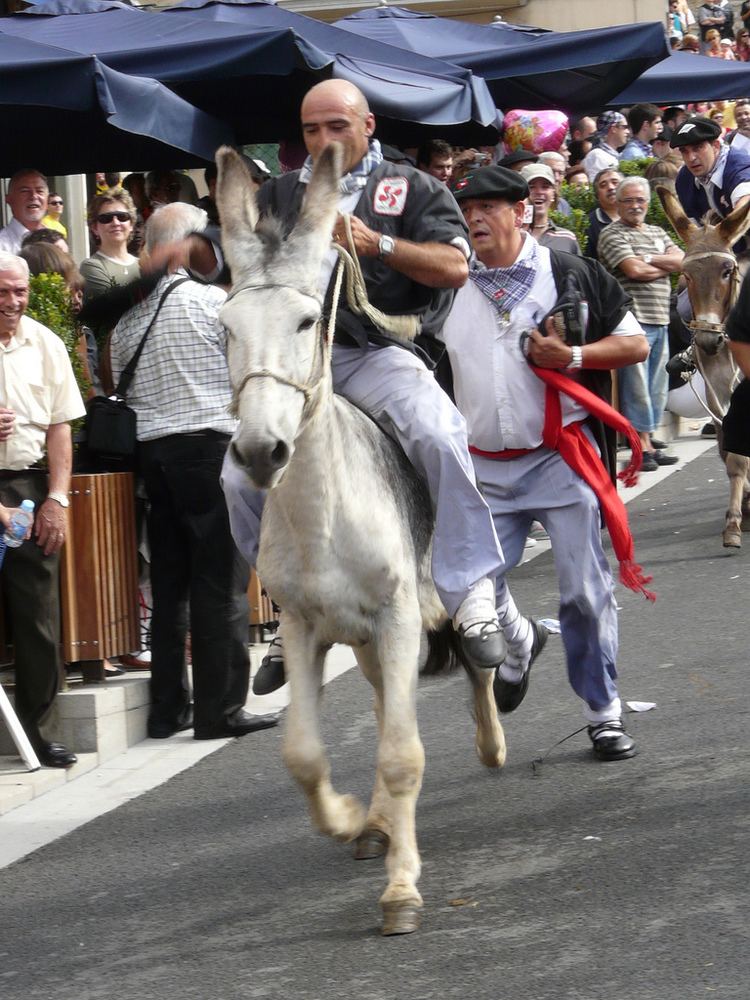 | ||
Blusas are Basque citizens who dress in traditional clothes from the region and attend events in Vitoria-Gasteiz (Basque Country) such as the Virgen Blanca Festivities. The blusas assemble in groups called cuadrillas and their main role is to provide entertainment on the days of these events.
Contents
Etymology
Etymologically, blusas comes from the Basque language and refers to the typical blouse worn in the festivities. However, this word was a loanword from the Spanish blusa describing the clothes used in the countryside by farmers. It was also a loanword from the French blouse which had a German origin.
History
These festivities have a rural origin and throughout history they have been developed in accordance with the population. Even though the beginning of blusas tradition is pretty unknown, it is believed that it may have a direct relationship with the myth of Celedón. There are several versions of this story as the transmission of data was done by the word of mouth. However, the following two have been reckoned by the Basque traditions as the most reliable ones:
- The first one tells the story of Celedonio Aizola, an outgoing bricklayer from Zalduondo. His fame came from his good people skills used in the Virgen Blanca Festivities several decades before. It is said that every time he stepped into this village, he made all the inhabitants gather in order to party with him. Later, in 1975, some friends of him came up with the idea of hanging an artificial figure which resembled Celedonio so as to make the Vitoria’s festivities start some year after the man’s death. Nowadays that invention is part of the tradition. The method is the same but instead of just holding it static, it moves along the Virgen Blanca Square pushed by some ropes.
- The second hypothesis is about Celedón Iturralde. A friend of his, Pedro Fernandez de Retana, who was the organist of Vitoria around the 1870s, took the role of organizing this village's festivities. This man, emphasised in telling that he was doing it as a memorial of Celedon iturralde, who died 12 year before in the Carlist Wars. In 1918, Mariano San Miguel gathered all the typical songs of the festivities into a song book, and among them, there was the one which Celedón wrote with the strophe that sounds non-stop in the festivities “Celedón ha hecho una casa nueva. Celedón, con ventana y balcón”. These lines talk about the house which was made by Celedón in Bitoriano (a small village next to Vitoria) where he had a balcony and a window (said in the song several times).
This emblematic character of the Basque was undoubtedly the origin of the festivities of Vitoria-Gasteiz. It is a mystery when did officially the blusas and neskas start with the tradition of dressing up but it is believed that at the very beginning, there used to be only men. However, those ancient characteristics have gradually changed up to the point that nowadays almost every cuadrilla are mixed. One curiosity could be that it is thought blusas have celebrated this tradition from its very beginning to nowadays inconstantly, but after the civil war and the time of the dictation this tradition disappeared for some years.
The “cuadrillas” nowadays
These groups are usually thought to be just the grouping of inhabitants in the festivities but it is far more than that. In fact, they give social aid by going to elderly's residences or organizing special events for children during the year. Also their brotherhood goes much further as in other festivities such as “San Prudencio” they also hang up. The cuadrillas, have the curiosity that inside them there are not real rules. Nevertheless, they do have some unwritten ones, which are given from the veterans to the freshmen. Besides, everybody has the opportunity to join these groups in exchange of some money.
Their routine during Festivities
They basically are the main cheerleaders of these days and hence, their routine is connected with it. Their activities could be divided into two parts:
Attire
The blusas wear the typical rural attire of the Araba natives that used to wear. It consist on a shirt, a “blusa” (blouse), a pair of trousers and the “albarcas” whereas “neskak” wear a blouse, long skirt and “albarcas”.
